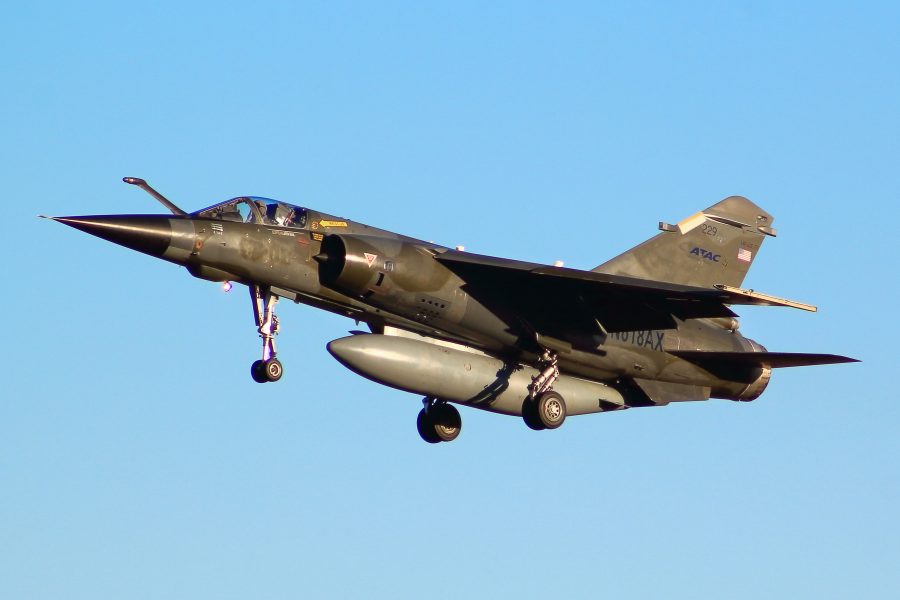Air Combat Command on July 21 awarded three companies contracts worth up to $433.6 million to provide 5,418 annual sorties of adversary air support at five bases over the next four and a half years, a command spokesperson told Air Force Magazine.
The contracts with Airborne Tactical Advantage Company, Tactical Air Support, and Draken International are the first to be awarded under the larger Combat Air Force/Contracted Air Support indefinite delivery, indefinite quantity contract, which is envisioned to eventually include 40,000 hours of adversary air at 12 fighter bases, plus 10,000 hours of close air support training at nine bases, with a final price tag worth up to $6.4 billion.
ATAC received two contracts worth up to $240 million over 4.5 years, if all options are exercised, to provide adversary air services at Luke Air Force Base, Ariz., and Holloman Air Force Base, N.M.
The company, part of the Textron Systems segment of Textron Inc., was contracted to fly up to 1,530 annual sorties in support of the F-35 formal training unit at Luke and 1,558 annual sorties in support of the F-16 FTU at Holloman.
ATAC will keep six of its supersonic F1 Mirage aircraft, which it procured from the French Air Force in 2017, at each location. The company has 90 days from contract award to get its fleet up and running, though Richard Zins, ATAC’s vice president of business development, said the goal is to start operating much sooner than that.
“We were fortunate enough to get a good head start on this, so that we have certified airplanes ready to go, ready to fly,” Zins told reporters in a July 27 teleconference. “In fact, some of those airplanes have been exercised … under a U.S. Navy contract, where we have over 100 sorties … flown for the U.S. Navy and Marine Corps.”
Ten of the 12 jets to be allocated to Luke and Holloman have received their Federal Aviation Administration airworthy certification, and five are certified to fly for the U.S. Navy. However, they cannot fly for USAF until they receive Air Force military flight certification, a process Zins said is “in the works and imminent.”
ATAC’s F1s have been “extensively modified” to include advanced GPS and an upgraded glass cockpit. The company also is planning to upgrade the jets’ radars with active electronically scanned array radars “in the near future,” Zins said.

Tactical Air Support also received a contract worth up to $90.4 million to fly 800 annual Red Air sorties in support of the F-15C/D FTU at Kingsley Field Air National Guard Base, Ore. The Reno, Nev.,-based company already flies adversary air in support of the U.S. Navy at Naval Air Station Fallon, Nev.
The company’s F-5 Advanced Tigers have been modified to include a new Garmin 3,000 flight deck that includes a 14-inch bevel display and two 5×7 displays. Tactical Air Support pilots also fly with the Thales Scorpion helmet mounted cueing system, which improves situational awareness by taking information normally visible on the Heads Up Display and putting it on a piece of glass in front of the pilot’s eye.
Mick Guthals, senior manager of business development at Tactical Air Support, said the company plans to support the F-15C training syllabus with up to six F-5s, which it hopes to have flying by Sept. 30. “Our jet build, while impacted by COVID, is progressing and we don’t anticipate any delays in aircraft availability,” Guthals told Air Force Magazine.

Draken, which already flies Red Air in support of the U.S. Air Force Weapons School at Nellis Air Force Base, Nev., also was awarded two contracts to support the F-15E FTU at Seymour Johnson Air Force Base, N.C., and the F-16 FTU at Kelly Field, Texas. The $74.5 million contract for Seymour Johnson covers 1,000 annual sorties, while the $28.2 million Kelly Field contract covers 530 annual sorties as well as temporary duty assignment exercise support.
Draken acquired 12 South African Atlas Cheetah supersonic fighters in 2017 and 22 F1s, mostly from the Spanish air force, which are being reassembled at its Lakeland, Fla., facility. In addition, Draken owns nine Aermacchi MB-339s, 27 MiG-21s, 21 L-159s, 13 A-4s, five L-39s, and one T-33.
ACC boss Gen. James M. “Mike” Holmes has said that when it comes to contract adversary air, the command is prioritizing fighter training bases as it looks to increase the number of pilots moving through the pipeline. ACC announced in March it planned to award contracts for six bases this year. Eglin Air Force Base, Fla., which was expected to get up to 1,100 annual sorties, is the only contract not yet awarded.
“ACC is working on an environmental assessment for the potential use of
adversary air sorties at Eglin AFB. Pending completion of the environmental assessment, contracted adversary air sorties would support the 33d Fighter Wing at Eglin AFB and the 325th Fighter Wing from Tyndall [Air Force Base, Fla.], which is temporarily operating from Eglin AFB,” ACC spokesperson Leah Garton said.
Seven companies were awarded IDIQ contracts in October 2019, allowing them to bid on specific task orders. Other companies include: Air USA, Blue Air Training, Coastal Defense, and Top Aces Corp.
